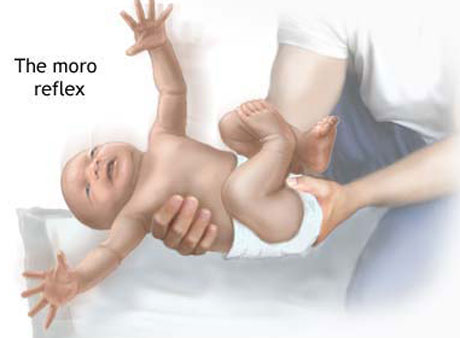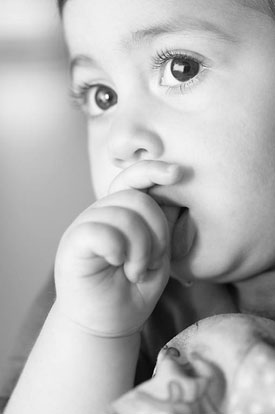A baby’s movements are governed by reflexes. These reflexes are somewhat automatic and not in his control. To give an example if one strokes a newborn's hand or foot on either the top or back then whole arm or leg withdraws slightly and then the feet or hands flex and turn. They turn as a mechanism to grasp your finger. This withdrawal reflex is present till the baby starts using his limbs in other ways, for example, standing, holding hands, etc.
The walking or stepping reflex:
A newborn displays many other reflexes. If he is held in a standing position such that the sole of one foot mildly presses the surface, the baby will immediately draw up legs successively just like we do while walking. Of course, his muscles do not have that strength to walk but the motion reflex in itself says a lot. This reflex vanishes after a year only to manifest itself as the art and style of walking. So we have the reflex at birth and when we have the strength we put it to use and start walking.
The Moro’s or startle reflex:

This is the one reflex that is quite frequent. Moro or startle reflex is brought on with sudden or loud noise, seeing very bright light, or with sensation of falling. This causes a young baby to extend legs, arms, fingers, arch back, draw head back, then draw arms back, and clenching of fists. Moro reflex appears to newly born babies and then it is found to disappear when the baby attains the age of three or four months. To calm the baby if suddenly startled like this, you should apply gentle pressure on any part of his body. For example, keeping your hand on baby’s chest and gently pressing it may be reassuring to the baby and may help calm him.
Babinski’s reflex:
Try stroking different parts of your infant's body. If you stroke the palm of his hand or the sole of his foot at the base of the toes, he will grasp your finger. Stroking the outside of the infant's sole sets off an reflex called the Babinski. The sign of Babinski’s reflex is that the baby’s toes will spread and the big toe will shoot up in the air.
Shooting reflex and sucking reflex:
As you will learn as soon as you start feeding your baby, stroking his cheek or around his mouth makes him root or turn toward the stroking object. This shooting reflex helps him find the breast, and the sucking reflex follows. Touching the inside of his mouth, which is more sensitive than the surrounding area, stimulates this reflex most. A bottle is thus easier to suck than the breast because the bottle touches this area.

Because of this reflex, a newborn often sucks on his fist noisily for long periods (fifteen minutes or so), and he does this so energetically that his whole body tenses and changes color until he loses his fist and random activity takes over. You need do little to start this hand-to-mouth cycle. Hand-to-mouth activity and finger sucking are probably common in the womb. In fact, pediatricians and obstetricians have seen these right after delivery. A premature newborn struggling to survive can actually clear his air passage by sucking on his fist and swallowing the mucus that chokes him.
Palmar grasping reflex:
When we place a finger in the baby’s palms, this reflex is triggered and the baby tries to grasp the finger with his hand. His grasp is very strong and if we put our finger in his hand we can feel the clench of the baby and its strength. It is quite remarkable and we are just filled with joy when a baby demonstrates this reflex. Palmar grasping reflex is special for parents because it gives us a feeling of our baby wanting us. Indeed a very strong feeling for parents.
Tonic neck reflex:
When we place the baby on his back, the baby would come into sort of a fencing posture. To demonstrate the reflex, turn the head of the baby to one side and you will notice that the arm on that side straightening out while the arm that is on the opposite side will tend to bend. This motion may, at times, be very slight and we may not notice it in its full force.
Swimming reflex:
If an infant is placed in a pool with the face down, we will find that the baby starts to kick and starts paddling obtaining a swimming posture. However, it is advised not to every try this reflex in an infant because they tend to swallow a lot of water which is not good. So do not try to elicit this reflex in a newborn and save it for later.
An important note:
As a parent, we are quite concerned about the baby and are quite anxious so some parents may try to elicit the aforementioned reflexes at home which is quite understandable but one should also maintain an amount of caution. Also of importance is the fact that if parents try to obtain these reflexes at home, they may not succeed at times and that may be due to a lot of factors like the baby may be hungry or the baby may just be fatigued, so if you are not able to obtain a reflex in your first attempt then there is no cause of alarm, you can certainly try the next day or after some time. However, even after repeated attempts if a reflex cannot be elicited then it is advisable to consult the pediatrician and inform him of the same and he may be able to do that for you. We are not trained and so may not be able to obtain these reflexes, however the doctor would be easily able to obtain these and they generally do check these before discharging the baby home.

